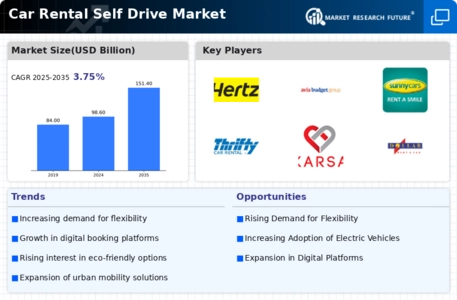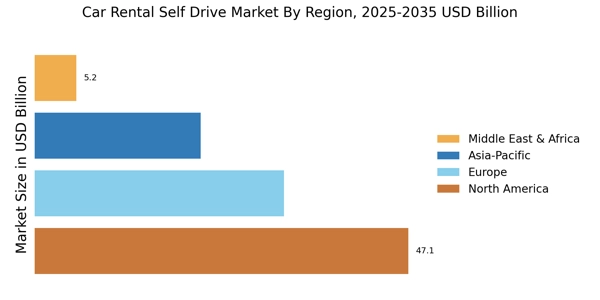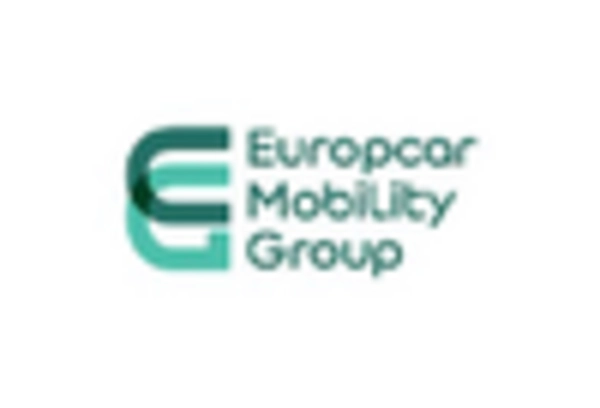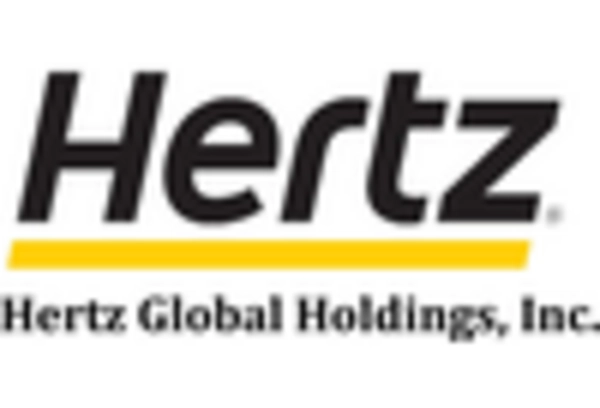Increased Urbanization
The trend of urbanization appears to be a significant driver for the Car Rental Self Drive Market. As more individuals migrate to urban areas, the demand for flexible transportation options rises. Urban dwellers often prefer self-drive rentals over ownership due to limited parking and high maintenance costs associated with personal vehicles. According to recent data, urban populations are projected to reach 68% by 2050, which could lead to a substantial increase in the self-drive rental segment. This shift in demographics suggests that the Car Rental Self Drive Market may experience heightened demand as urban residents seek convenient and cost-effective mobility solutions.
Technological Advancements
Technological advancements are reshaping the Car Rental Self Drive Market, enhancing customer experiences and operational efficiencies. Innovations such as mobile applications for booking, GPS navigation, and contactless pick-up and drop-off services are becoming standard. Data indicates that the integration of technology in rental services has led to a 25% increase in customer satisfaction ratings. Furthermore, the rise of electric and autonomous vehicles is likely to influence the market, as consumers become more environmentally conscious. The Car Rental Self Drive Market may thus evolve rapidly, adapting to these technological changes to meet the expectations of a tech-savvy clientele.
Evolving Consumer Preferences
Consumer preferences are evolving, with a noticeable shift towards convenience and flexibility in transportation. The Car Rental Self Drive Market is likely to benefit from this trend as more individuals opt for self-drive rentals over traditional car ownership. A survey indicates that approximately 60% of millennials prefer renting vehicles for short-term needs, reflecting a broader societal change. This inclination towards self-drive rentals suggests that the market may continue to expand, driven by the desire for hassle-free travel experiences. As consumers increasingly prioritize experiences over possessions, the Car Rental Self Drive Market could see a surge in demand for diverse rental options.
Rising Environmental Awareness
Rising environmental awareness among consumers is driving the Car Rental Self Drive Market towards more sustainable practices. As individuals become increasingly concerned about their carbon footprints, there is a growing demand for eco-friendly vehicle options. Data suggests that rentals of hybrid and electric vehicles have surged by 30% in recent years, indicating a shift in consumer preferences. This trend may compel rental companies to expand their fleets to include more sustainable options, thereby attracting environmentally conscious customers. The Car Rental Self Drive Market could potentially see a transformation as it aligns with the values of a more eco-aware consumer base.
Economic Growth and Mobility Needs
Economic growth in various regions is contributing to an increased demand for mobility solutions, thereby impacting the Car Rental Self Drive Market. As economies expand, disposable incomes rise, leading to greater consumer spending on travel and leisure activities. Recent statistics show that the car rental sector has experienced a compound annual growth rate of 5%, reflecting the growing need for flexible transportation options. This economic trend suggests that more individuals may turn to self-drive rentals as a cost-effective alternative to owning a vehicle. Consequently, the Car Rental Self Drive Market is likely to thrive as it caters to the mobility needs of an increasingly affluent population.


















Leave a Comment